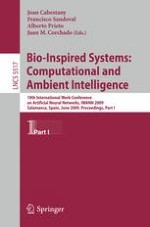This volume presents the set of final accepted papers for the tenth edition of the IWANN conference “International Work-Conference on Artificial neural Networks” held in Salamanca (Spain) during June 10–12, 2009. IWANN is a biennial conference focusing on the foundations, theory, models and applications of systems inspired by nature (mainly, neural networks, evolutionary and soft-computing systems). Since the first edition in Granada (LNCS 540, 1991), the conference has evolved and matured. The list of topics in the successive Call for - pers has also evolved, resulting in the following list for the present edition: 1. Mathematical and theoretical methods in computational intelligence. C- plex and social systems. Evolutionary and genetic algorithms. Fuzzy logic. Mathematics for neural networks. RBF structures. Self-organizing networks and methods. Support vector machines. 2. Neurocomputational formulations. Single-neuron modelling. Perceptual m- elling. System-level neural modelling. Spiking neurons. Models of biological learning. 3. Learning and adaptation. Adaptive systems. Imitation learning. Reconfig- able systems. Supervised, non-supervised, reinforcement and statistical al- rithms. 4. Emulation of cognitive functions. Decision making. Multi-agent systems. S- sor mesh. Natural language. Pattern recognition. Perceptual and motor functions (visual, auditory, tactile, virtual reality, etc.). Robotics. Planning motor control. 5. Bio-inspired systems and neuro-engineering. Embedded intelligent systems. Evolvable computing. Evolving hardware. Microelectronics for neural, fuzzy and bio-inspired systems. Neural prostheses. Retinomorphic systems. Bra- computer interfaces (BCI). Nanosystems. Nanocognitive systems.
